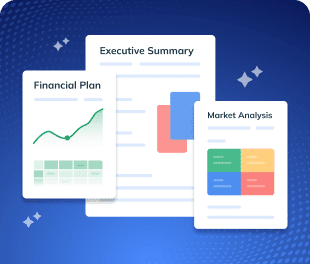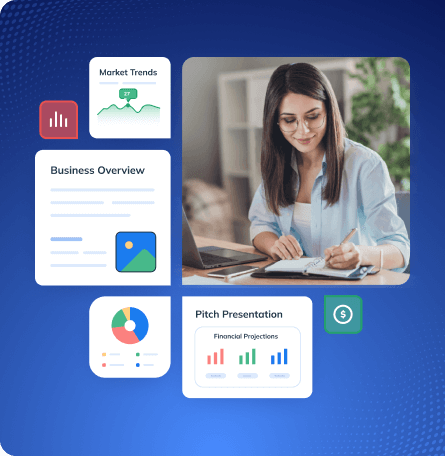Love fashion and helping people feel their best?
Personal shopping isn’t just a passion—it’s a growing business opportunity. With 81% of consumers wanting personalized experiences, now’s the perfect time to offer one-on-one style support.
But great style isn’t enough—you need a solid plan to turn your talent into a real business. A business plan keeps you focused, avoids mistakes, and sets you up for success.
In this guide, we’ll walk you through each step of building a strong business plan and share a free personal shopper business plan template to help you get started fast.
How to draft a personal shopper business plan?
Writing a personal shopper business plan is much easier than you think. You just need to work through section by section. Here’s a simple guide to the key components to include in your plan:
1. Executive Summary
The executive summary is the opening section of your personal shopper business plan. But it’s often easiest to write it last, after you’ve finished out all other details, as it provides a high-level overview of your entire business plan.
Keep this section about one page or less, and engaging. Because many people will read this part only, and it should give them the first impression of your business.
Here’s what to include to include in your executive summary:
- Business introduction – What is your business name? Where is it located? What core services do you offer?
- Market opportunity – Why is now a great time for a personal shopping service? Is there a growing demand for style help or shopping services in your area?
- Services and value proposition – What services will you provide? How is your approach different or better? Explain what problem you solve for your clients, and why they’ll choose you over others.
- Marketing and sales plan – How will you attract clients and generate revenue? Also, will you charge hourly fees or monthly packages?
- Financial highlights – How much money do you think you’ll make in your first year? Do you need a loan or funding to get started?
In short, this plan summary section is your chance to capture readers’ attention and make them learn more about your business. So, keep the tone clear and enthusiastic.
Say goodbye to boring templates
Build your business plan faster and easier with AI
Plans starting from $14/month

2. Business Description
The business description section of your plan provides detailed information about your personal shopper business itself. Think of it as an “about us” section where you give readers insight into your company’s identity, structure, and goals.
This section should answer fundamental questions like:
Who are you? What do you do? Why and how did you start this business?
Start with the basic details such as your company name, legal structure (sole proprietorship, partnership, LLC, or other entity), and location. Add a bit of history about your business. State when and why you founded this business.
Also, write about what differentiates your business—your mission, vision, and core values. Explain how your service makes shopping convenient for your clients.
Then, describe your future goals, such as increasing the team members or launching a complementary online boutique.
Keep this section engaging and tone confident. By the end of this section, the reader should feel like they know your business’s identity and direction.
3. Market Analysis
The market analysis section shows that you understand the personal shopping industry and the people you plan to serve. It helps prove that there’s real demand for your service.
Here’s what to cover in your market analysis:
Industry overview
Start by describing the personal shopping industry in broad terms. Is this a growing field? If possible, include a statistic to show the opportunity. For example:
“The personal shopping market is expected to be valued at $6.73 billion in 2025 and reach around $19.96 billion by 2032.”
Target market
Clearly explain who your ideal customers are. For example, they could be professionals aged 25–50 who are busy and need help shopping for clothes or gifts. Or they might be older adults who need help running errands.
Be clear about their age, income, lifestyle, and location.
You can also create a sample customer persona to show who your service is for. Something like this:
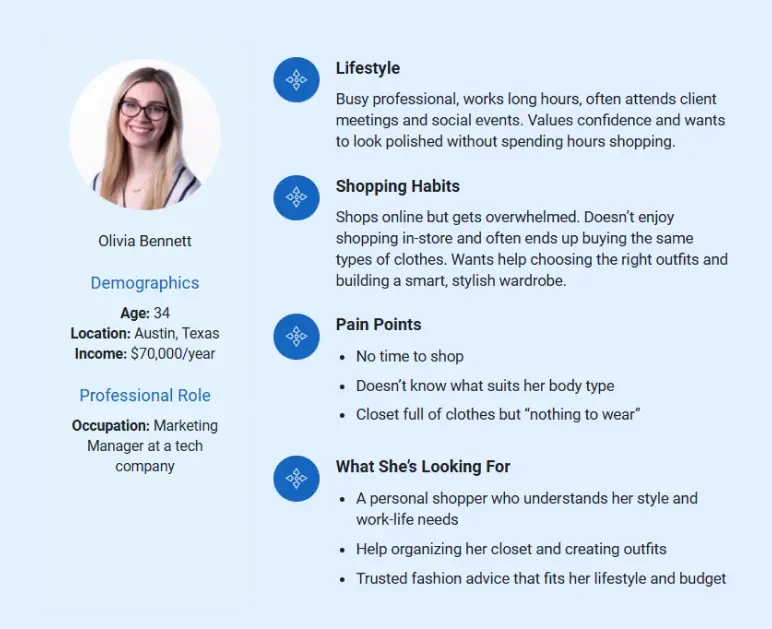
Market demand
Estimate the size of your target market and the demand in your area or niche. You can also use local data or industry reports. The goal is to convince readers that enough customers exist who are willing to pay for your service.
Key trends
Mention any trends that could impact your personal shopper business. For instance:
- More people shop online and feel confused by too many options
- Services like Stitch Fix have made personal shopping more common
- People care more about eco-friendly and sustainable fashion
- Virtual shopping and online styling are getting more popular
- Demand goes up during holidays and back-to-school time
Competitor analysis
Identify your direct competitors, such as other personal shoppers or stylists in your area offering similar services.
Also, list indirect competitors—solutions that meet the same need differently, like subscription styling boxes, concierge services with shopping, or department stores offering free personal shopping.
For each major competitor, note what services they provide. What is their pricing model? What type of client are they targeting?
You can also perform a SWOT analysis of your business to show your strengths, weaknesses, opportunities, and threats.
Regulatory or social factors
Consider if there are any regulations, licenses, or social factors affecting your business. If you plan on handling expensive purchases, you might consider insurance or bonding for liability.
By the end of this section, the reader should feel confident that there is a definable, reachable customer base for your personal shopper service and that you understand the market dynamics.
4. Services Offered
In this section, you’ll detail what services your personal shopper business will offer and how you’ll price those services.
Start by listing your main services:
- Personal shopping for apparel
- Wardrobe styling or closet audits
- Gift shopping
- Grocery or errand shopping
- Event or trip shopping
Describe each service briefly. Also, if you plan to offer bundle packages or tiers of services, outline them.
You can also sell products like a style e-book or host a paid workshop. These might be minor, but including them shows you’ve thought of multiple income avenues.
Now, explain how you price your services. Be as transparent as possible. Will you charge an hourly rate, flat fees for packages, or earn commissions?
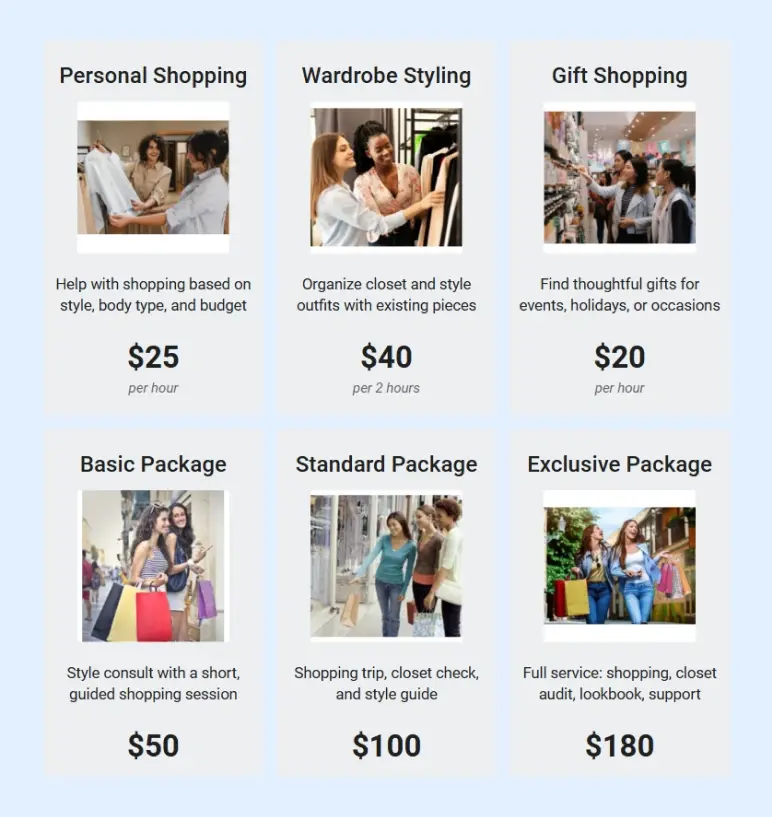
Avoid overly complex pricing schemes that might confuse clients.
Make sure everything is clear and easy to understand, so the reader knows exactly what you offer and how you make money.
5. Marketing Strategies
The marketing strategies section of your business plan explains how you’ll attract customers, convert them into clients, and retain them for repeat business.
Here are some marketing channels or sales tactics you can use to reach your target customers:
Social media: Post outfit collages, shopping hauls, and before-and-after client transformations on platforms like Instagram, Facebook, or TikTok.
Networking and referrals: Join local business groups, attend fashion events, or partner with boutiques or hair salons to get referrals.
Online presence: Make a professional website with testimonials, a portfolio, or an online booking system. Optimize for good SEO (e.g., “personal shopper [city]”).
Content marketing: Provide blogs, shopping tips, newsletters, or YouTube videos to build trust.
Paid advertising: Mention if you’ll use paid ads, like Facebook, Instagram, or Google ads.
Sales approach: Explain how the client onboarding process works.
- Offer a free consultation to discuss their needs
- Proposal or package recommendation
- Follow-up within a week
Use a CRM software to track client sizes, favorite brands, and past purchases.
Also, if you have any special marketing hooks, describe them too.
In short, this marketing section should show that you understand how to find your audience, earn their trust, and turn them into loyal clients.
6. Operations Plan
The operations plan details the practical aspects of how you’ll run your personal shopper business on a daily basis.
Here’s a list of questions to answer when drafting this section:
- Will you have a physical office or store, or meet clients at other locations? Will you keep any clothing or supplies in stock? If yes, what kind?
- How will clients contact you (phone, website, social media)? What will be your service delivery process from booking to wrap-up?
- What tools or apps will you use for scheduling, payments, or communication? Will you use any apps for planning outfits or managing client info?
- Do you have any connections with stores, sales staff, or boutiques? Will you work with couriers or delivery services to drop off items or handle returns?
- What days and times will you be available for clients? Will you offer evening or weekend appointments?
- Are you running the business alone or with help? Will you hire part-time help or assistants in the future?
- How will you make sure each client has a good experience? Will you ask for feedback after each session?
Try to cover all the operational aspects of your personal shopper business. A good operations plan convinces the reader that you can deliver your services reliably and efficiently.
7. Management Team
The management team section introduces the key people behind your business. Investors and lenders give significant weight to this section because a great idea needs capable people to execute it.
A personal shopping business usually starts with one person, so begin by talking about yourself. Share a short background that includes your experience, skills, education, and why you’re a good fit to run this business.
If you have any partners or employees from the start, mention them. For each person, mention their experience, skills, education, roles, and what they bring to the table.
If you plan to hire employees as you grow, mention your approach to recruitment and training. Even if you don’t have employees, you might have an advisory board or mentors. Listing advisors can add credibility.
Overall, the management team section helps people trust that your business is in good hands.
8. Financial Projections
Creating realistic financial projections shows the expected financial performance and requirements of your personal shopper business.
The goal is to demonstrate that your business is financially viable and give readers insight into the economics of your service.
Start by listing your initial startup expenses. This might include:
- Business registration and licence fees
- Setting up a website
- Marketing materials
- Subscription to any software or apps
- Insurance
Now, explain how your business will make money. In a personal shopper business, you primarily earn through client fees. But if you have any other revenue streams, like commissions or referral fees, mention that too.
Provide a forecast of your sales for at least the first 3 years.
Then, list your expected costs.
- Fixed expenses: Things you pay every month, like insurance, phone/internet bills, software subscriptions, coworking space fees, or loan payments.
- Variable expenses: Costs that change, like gas, parking, mileage, small client gifts, or refreshments.
Include basic financial statements for the next 3 years:
- Income statement
- Cash flow statement
- Balance sheet
Figure out your break-even point—how many clients or hours you need to cover your costs.
Lastly, if you’re asking for funding, clearly say how much you need and how you’ll use it. A simple chart can help show where the money will go. Here’s an example for that:
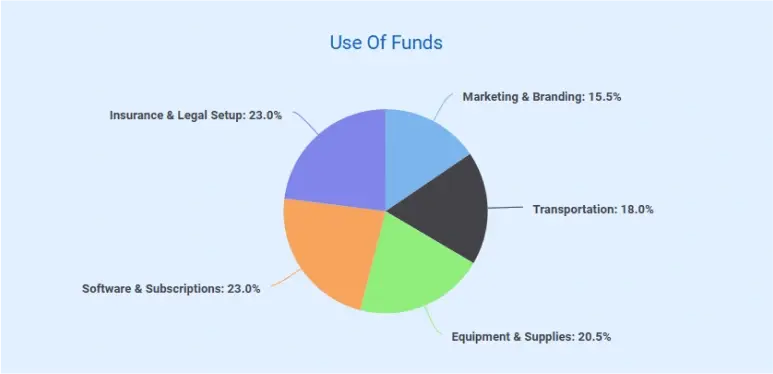
When writing the financial section, keep the language clear and avoid overly technical jargon. This section should show you understand your finances and can run a profitable business.
Why a business plan is vital for personal shopping services?
A business plan might sound like a big task, but it’s incredibly useful—even if you’re just starting out on your own. Here’s why a business plan matters:
- It gives you direction. It helps you decide what kind of shopping help you’ll offer, who you want to work with, and how to stand out from others.
- You’ll know your customers better. A bit of research helps you learn what your clients need and how you can help them best.
- It helps you manage your finances. You can plan your prices, understand your costs, and see how you’ll make a profit.
- It shows you’re serious. If you want a loan or want to partner with a boutique, your plan shows you’re ready and professional.
- It keeps you on track. You’ll set clear goals and stay organized. As your business grows, you can update your plan anytime.
In short, a business plan helps you start with confidence, stay focused, and build a successful personal shopping business.
Download a free personal shopper business plan template
Ready to write your own personal shopper business plan? We’ve got you covered! You can download our free personal shopper business plan template PDF to kickstart your planning process.
This template is pre-formatted with all the key sections typically found in a business plan and includes sample content to guide you. Simply fill in the details specific to your personal shopping service, and customize it as needed.
The Quickest Way to turn a Business Idea into a Business Plan
Fill-in-the-blanks and automatic financials make it easy.
Conclusion
You now have a clear idea of how to write a personal shopper business plan—from defining your vision and target market to setting your pricing, marketing strategy, operations, and financial goals.
However, if you’re still feeling stuck or need more assistance with your plan, Upmetrics can help.
It’s an advanced AI-powered business planning tool that handles the writing, formatting, and numbers, so you can focus on doing what you love: helping clients shop and feel their best.
Why wait? Start building your personal shopper business plan today!
